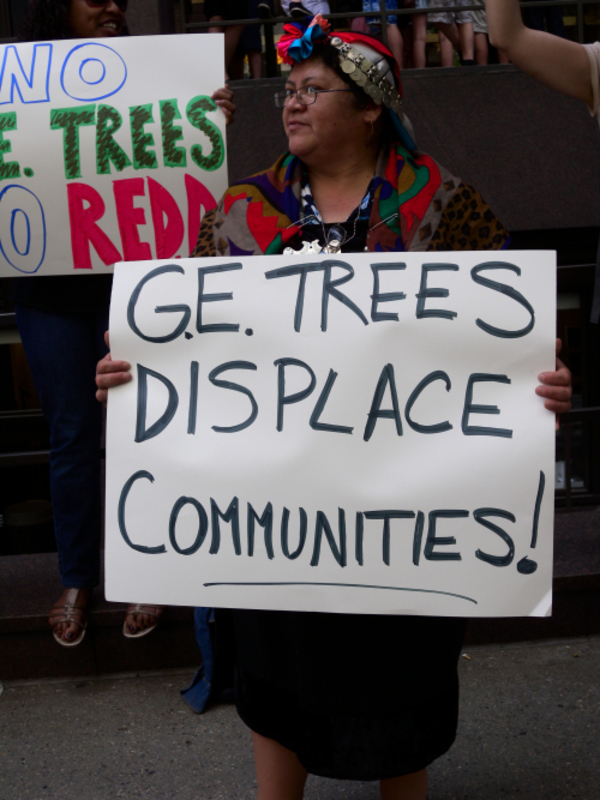GE trees to fight climate change?
Dr. Rachel Smolker | 09 April 2013 | corporations, climate crisis, GMOs | United States Mapuche woman protests outside of the Belgian Mission in Manhattan. Photo: Langelle
Mapuche woman protests outside of the Belgian Mission in Manhattan. Photo: LangelleThe realities of climate change have become altogether painfully obvious. Many are working to address this by reducing consumption, and protecting landscapes and biodiversity.
ArborGen and other tree biotechnology companies, however, have a different vision. They want to develop so-called “bio-energy” from massive plantations of genetically engineered (GE) trees across South Carolina, Georgia, Florida, Alabama, Mississippi, Louisiana and Texas. They are banking on the fact that most renewable energy subsidies are directed towards wood-based bioenergy– funding refineries to convert wood into liquid biofuels, and to construct new facilities — and convert aging coal-fired plants — to incinerate massive quantities of wood for electricity.
In the U.S. and Europe, bioenergy already is the second largest form of renewable energy (excluding hydro) and the IEA estimates that bioenergy will be the most rapidly growing renewable, through 2035. [1] In Europe, coal-fired plants are undergoing conversion to burn trees. These plants depend almost entirely on imports — resulting in a rush to build facilities to transform southern forests into wood pellets for export. A growing coalition is mobilizing to stop this. We are arguing against mandates and subsidies for ethanol, warning of food vs. fuel competition, and pointing out that burning trees for electricity is unwise since protecting forests is one of our best lines of defense against climate change. Further, burning wood releases more CO2 per unit of energy than even coal. Finally, it would take much of the planet’s land, water, soil and fertilizers to grow enough biomass to meet just a fraction of the current demand for energy. The consequences would be disastrous.
The Obama administration, however, along with the U.S. Energy and Agriculture departments, biotechnology companies, big oil, agribusiness and others— are steaming forward on bioenergy, pumping money into research and development. In 2010, ArborGen won USDA permission to field-test a quarter million of their GE eucalyptus trees across seven southern states, a decision that was challenged in the courts. The Obama administration has vowed to streamline permitting for GMOs, further impacting their already grossly inadequate assessment of risks for these new technologies. The “Stop GE Trees Campaign”, consisting of 245 groups who support a global ban on the release of GE trees, is rallying forces and organizing a series of protests and other events around the upcoming Tree Biotechnology 2013 conference in Asheville, NC this May. For without significant public outcry, ArborGen could soon be growing plantations of GE eucalyptus trees across the Southern U.S.
What will this mean? Eucalyptus is native to Australia. In Florida and California, it is a documented invasive species. Eucalyptus is designed to access water in dry places; and effectively suck soils and waterways dry. The US Forest Service estimates they would double water use compared with native forests. Eucalypts contain oils that not only grant them their unique odor, but also make them highly flammable; a major factor in the horrific wildfires that have plagued Australia. Does it make sense to plant trees which have been dubbed both “living firecrackers” and “flammable kudzu” in our already drought-stricken southern states, just as we are facing severe heating and drying impacts of climate change? Plans for GE poplar and pine trees raise an additional frightening prospect — contamination of native trees. Pollen from GE poplars and pines will blow in the wind and find its way to native forests. Contamination would be both inevitable and irreversible.
Does it make sense to introduce genetically engineered trees, to be grown en masse; displacing native forests, cultivated with toxic fertilizers and pesticides to supply wood to facilities that can never provide more than a tiny fraction of our overall energy demand? It’s time for a reality check; quick before it’s too late.
Source: http://climate-connections.org
No comments:
Post a Comment